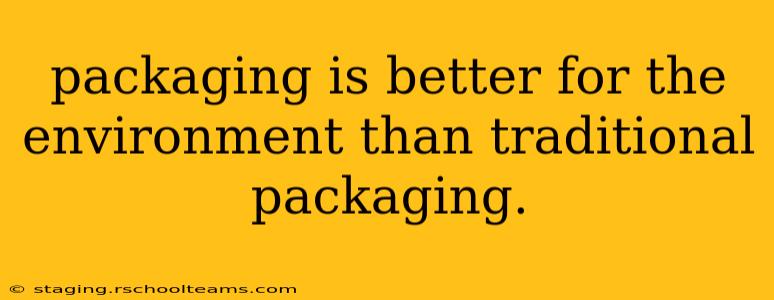The rise of eco-consciousness has spurred a surge in sustainable packaging options, prompting many consumers to wonder: is sustainable packaging truly better for the environment than traditional packaging? The answer, while seemingly straightforward, is nuanced and depends heavily on several factors. Let's delve into the complexities of this crucial question.
What Constitutes "Sustainable" Packaging?
Before comparing sustainable and traditional packaging, it's essential to define what constitutes "sustainable." Sustainable packaging prioritizes minimizing environmental impact throughout its lifecycle – from material sourcing and manufacturing to its use, disposal, and potential recycling or composting. This involves considering:
- Material Choice: Using renewable resources like bamboo, recycled paperboard, or plant-based plastics instead of virgin materials.
- Manufacturing Process: Employing energy-efficient production methods and minimizing waste during manufacturing.
- Design for Recyclability/Compostability: Creating packaging that's easily recyclable or compostable, avoiding complex or mixed materials that hinder proper waste processing.
- Reduced Packaging Weight and Volume: Minimizing the amount of material used without compromising product protection.
- Transportation Efficiency: Optimizing packaging design and logistics to reduce transportation emissions.
Is Sustainable Packaging Always Better Than Traditional Packaging?
While the intention behind sustainable packaging is undeniably positive, its overall environmental impact isn't always superior to traditional packaging. This is because:
- "Greenwashing" is a Concern: Some companies might label packaging as "sustainable" without genuinely meeting environmental standards. It’s crucial to look beyond marketing claims and investigate the packaging’s composition and lifecycle.
- Production of Sustainable Materials: Producing some sustainable materials, like certain bioplastics, can be energy-intensive, potentially offsetting some environmental benefits.
- Recycling Infrastructure: The success of sustainable packaging hinges on adequate recycling and composting infrastructure. If these systems are lacking, even the most eco-friendly packaging might end up in landfills.
- Transportation Distance: The distance materials are transported can significantly affect the overall carbon footprint. Locally sourced sustainable materials have a smaller environmental impact than sustainable materials shipped from across the globe.
What are the Different Types of Sustainable Packaging?
Several types of sustainable packaging are emerging, each with its own advantages and disadvantages:
- Biodegradable Packaging: Made from materials that naturally decompose, often requiring specific composting conditions.
- Compostable Packaging: Designed to break down in industrial composting facilities.
- Recyclable Packaging: Can be reprocessed into new packaging or other products.
- Reusable Packaging: Intended for multiple uses, reducing the need for single-use packaging.
How Can I Choose Environmentally Friendly Packaging?
Choosing truly environmentally friendly packaging requires diligent research. Look for certifications like those from organizations specializing in verifying sustainable practices. Consider:
- Material Composition: Choose packaging made from recycled content or renewable resources.
- Recyclability or Compostability: Ensure the packaging can be properly recycled or composted in your area.
- Minimalist Design: Opt for packaging that uses the least amount of material necessary.
What are the Environmental Impacts of Traditional Packaging?
Traditional packaging often relies on virgin materials derived from fossil fuels and often involves non-recyclable or difficult-to-recycle materials. This contributes to:
- Deforestation: The use of virgin paperboard can lead to deforestation.
- Fossil Fuel Dependence: Plastic packaging production depends heavily on fossil fuels.
- Landfill Waste: Non-recyclable packaging ends up in landfills, contributing to pollution and resource depletion.
Conclusion: A Balanced Perspective
While sustainable packaging offers a promising path toward a greener future, it’s crucial to approach the topic with a balanced perspective. Not all sustainable packaging is created equal, and the effectiveness of these options depends heavily on responsible production, consumer behavior, and robust waste management systems. By educating ourselves about different packaging types and making informed choices, we can contribute to reducing the environmental impact of packaging and moving towards a more sustainable future.
